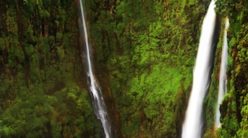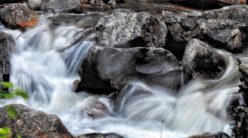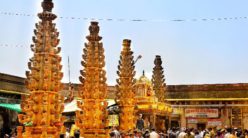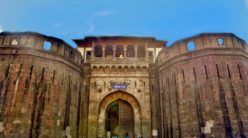
Raigad is fort which is situated on big hill in the mahad. This is one of the important historic place in the history of Marathas. Raigad is first capital of independent Marathi kingdom. Chhatrapati Shivaji Maharaj has made this fort the capital of his empyrean the year 1674. The fort rises 2,700ft above the sea level and is located in the Sahyadri mountain range. There are approximately 1737 steps leading to the fort.the Raigad ropeway, an Ariel tramway exists to reach top of the fort in 10 min.

Raigad is well surrounded by Sahyadri mountains and was considered as secured.
Raigad was known as ’’RAIRI’’ before it was captured by Shivaji Maharaj. Due to its impregnability, Raigad was known as “Gibraltar of East”. In the 16th century, when it was not developed as fort, it was called by local people as “rashivata” and “Tanas”. Due to its shape of a tall oil lamp tower, it was also called as “Nandadeep”. The fort was called by 15 different names by different people at different time-
Raigad, Rairi, Raigiri, Bhivgad, Reddi, Shivlanka, Islamgad, Nandadeep, Jambudweep, Tanas, Rashivata, Badenur, Rajgiri, Rahir, Gibraltar of the east.
There is the Raigad Ropeway which helps visitors to reach the Raigad Fort, avoiding the arduous climb. It is a rather picturesque climb through the mist-laden clouds, touched upon by the wind. The Ropeway, built in 1996 which an interesting element of the fort, lands at the Mena Darwaja.
ABOUT RAIGAD FORT STRUCTURE
The Raigad Fort was built by Chatrapati Shivaji Maharaj, Maharashtra and the chief architect/engineer was Hiroji Indulkar. The main palace was constructed using wood, of which only the base pillars remain.
Queens quarters-
The main fort ruins consist of the queen’s quarters, six chambers, with each chamber having its own private restroom. In addition, ruins of three watch towers can be seen directly in front of the palace grounds out of which only two remain as the third one was destroyed during a bombardment.
Market –
The Raigad Fort also has ruins of a market which was accessible to horseback riders.
Ganga sagar lake-
The fort also overlooks an artificial lake known as the Ganga Sagar Lake.
The Maha Darwaja
The only main pathway to the fort passes through the “Maha Darwaja” (Huge Door) which was previously closed at sunset. The Maha Darwaja has two huge bastions on both sides of the door which are approximately 65–70 feet in height. The top of the fort is 600 ft above this door.
Hirkani buruj-
The fort has a famous wall called “Hirakani Buruj” constructed over a huge steep cliff. The legend goes “that a woman by the name of Hirakani from a nearby village had come to sell milk to the people living at the fort. She happened to be inside the fort when the gates got closed and locked at sunset. Hearing the cries of her infant son back at the village echo after nightfall, the anxious mother couldn’t wait till dawn and courageously climbed down the steep cliff in pitch darkness all for the love of her little one.
She later repeated this extraordinary feat in front of Chatrapati Shivaji Raje and was bravely rewarded for it.” In appreciation of her courage and bravery, Chatrapati Shivaji Raje built the Hirakani Bastion over this cliff.
Darbar-
 inside the Raigad Fort has a replica of the original throne that faces the main doorway called the Nagarkhana Darwaja. This enclosure had been acoustically designed to aid hearing from the doorway to the throne.
inside the Raigad Fort has a replica of the original throne that faces the main doorway called the Nagarkhana Darwaja. This enclosure had been acoustically designed to aid hearing from the doorway to the throne.
Mena or palakhi darwaja-
A secondary entrance, called the Mena Darwaja, was supposedly the private entrance for the royal ladies of the fort that lead to the queen’s quarters. The convoy of the king and the king himself used the Palkhi Darwaja.
To the right of Palkhi Darwaja, is a row of three dark and deep chambers. Historians believe that these were the granaries for the fort.
The Takmak Tok
From the fort, one can view the execution point called Takmak Tok, a cliff from which sentenced prisoners were thrown to their death. This area has been fenced off.[4]
The statue of Chatrapati Shivaji Raje is erected in front of the ruins of the main market avenue that leads to the Jagdishwar Mandir and his own Samadhi and that of his loyal dog named Waghya. The Samadhi of Jijabai, Shivaji’s mother, can be seen at base village of Pachad.
MINT (Taksal)
A plant where money is coined by authority of shivajimaharaj on raigad.
Vijay stambh-
Whenever Chhatrapati Shivaji maharaj used to win a fort, a huge bhagva flag used to be hosted on this stambh which have 7 floors to let all people know about win to boost moral.
Jagdishwar temple;
jagdishwar temple was of lord shiva.It is praised for its architecture, becouse of the constant mughal attacks the temples on diffrent forts including Raigad , so Shivaji maharaj built it in mughal architectural style so that the temples will not be fallen. The Mughals had a large hieght taking advantage of this he bult small doors so that the mughals cannot enter the temple.
Shivaji maharaj samadhi-
shivaji maharaj samadhi is near jagdishwar temple there is one dog statue which is behind this samadhi.The samadhi of Shivaji maharaj was found by Mahatma jotirao phule in 1880 when walked all the way from pune to raigad to locate samadhi of Shivaji maharaj . It was lost amongst the dense trees he cleared it and paid respect to his great king.
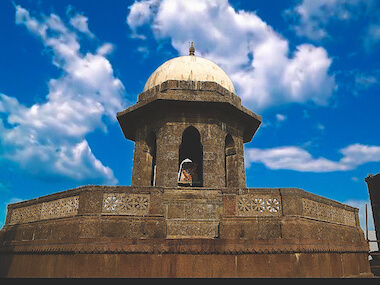
for more details subscribe my youtube channel







